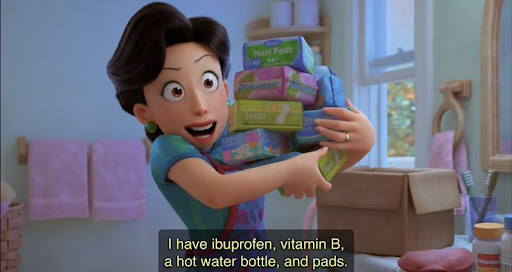Pixar’s “Turning Red” holds nothing back and it’s awesome

Photo courtesy of @loverlydarling
“Turning Red” is very open about topics such as periods and puberty, which aren’t often addressed in movies for young audiences.
Disney Pixar’s new animated movie “Turning Red” is by far their most progressive, covering often-taboo topics such as periods, sexual attraction, and puberty, with grace.
The movie follows Meilin, a 13-year-old Chinese-Canadian girl, as she navigates puberty, middle school, and her mother’s overbearing expectations. When she discovers that her family’s ancestral connection to Red Pandas gives her the ability to turn into one when experiencing high emotion, her life changes in a way she could have never imagined.
The film is extremely open about topics not often discussed in movies, especially not those targeted at children. This includes periods, with the film specifically referencing pads and hot water bottles. This representation has been a source of both praise and criticism for the film, with some saying the movie is inappropriate rather than destigmatizing.
“The movie is very much meant for a pre-teen crowd, and I think it wasn’t advertised as such which is why some people are angry, but even so, I don’t really think that there’s a hard limit to teaching about puberty.” said senior Samantha Stinson. “I think normalizing [periods and puberty] is super super important [and it’s] not fair for young girls to feel like they’re gross or they need to hide their normal bodily functions, and it causes a lot of insecurity that’s already placed upon them.”
The movie also depicts the realities of being a tween girl, with Meilin’s awkward outgoingness, newfound attraction to boys, and diehard love for boy band “4*TOWN.”
“I think that the movie also applies to a very nerdy [and] loner audience, and it’s especially important that those kids feel supported and represented in media,” continued Stinson. “It’s a product of sexism, but media has painted teenage girls as cringe-worthy or laughing stock, and feminine traits are definitely not something to look down upon.”
An animated children’s movie being so open about puberty was shocking in the best way possible. Too often puberty is treated as taboo and gross, leaving tweens feeling ashamed of their bodies and the changes they’re going through. A film for young teenagers, about young teenagers, is rare and it represents a huge step towards destigmatizing normal physical changes that many tweens feel like they have to go through alone.
“I feel that it is important to destigmatize these parts of adolescence and this movie does a good job of portraying the shame that is felt without perpetuating the idea that it should be shameful.” said senior Claire Li. “Growing up in a Chinese household, I always felt that my experience with periods, puberty, sexuality, relationships, and even the integration of my school [and] home cultures was never quite accurate to what I saw in movies. Turning Red represents these changes in a way that is sensitive to my own cultural experience while addressing them without stigma.”
Beyond covering important topics about growing up, the movie also does a wonderful job at capturing the early 2000s era. From the 2002 clothes to the girls’ tamagotchis, the movie is a charming blast from the past for audiences who were Meilin’s age around 2002.
“I think the way they framed [the time period] definitely didn’t limit the audience to just 90s kids, and the target audience is still definitely current pre-teens, but it did capture a sort of generational trauma for kids who did grow up at the time.” continued Stinson.
The movie also does an excellent job at depicting Chinese culture. Meilin works with her parents in their family’s temple, the oldest traditional Chinese temple in Toronto, with beautifully animated traditional architecture. The movie also depicts Chinese food through small animation details such as runny egg yolks and flour on dumpling wrappers that make your mouth water.
“The architecture of the temple was a clever way to pay homage to typical Asian architecture without caricaturing an ‘Asian landscape.’” said Li. “The food reminded me of the short film Bao. It was very typical of Chinese home food, without being depicted as foreign or gross.”
Additionally, Meilin’s relationship with her family is very true to traditional Chinese family roles, and the film brings representation to those who saw their own family dynamic in Mei’s experience.
“The aggressive feeding, the acts of service, the aunties, and this very Eastern collectivism that puts [on] a lot of pressure is so accurate. The little details are beautiful as well; the way that Mei doesn’t understand [Cantonese], the repetition of a broken mother-daughter relationship, hit so close to home for me.” said Stinson.
Overall, “Turning Red” is a lovely and charming movie about self discovery, family, friendship, and growing up. Heartwarming, hilarious, and beautifully animated, the movie is great for anyone and everyone, and leaves those who relate to Meilin’s experiences feeling represented and seen.





